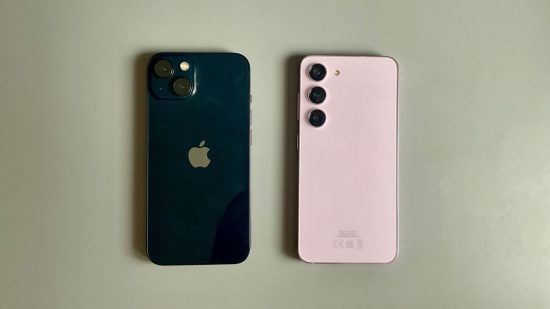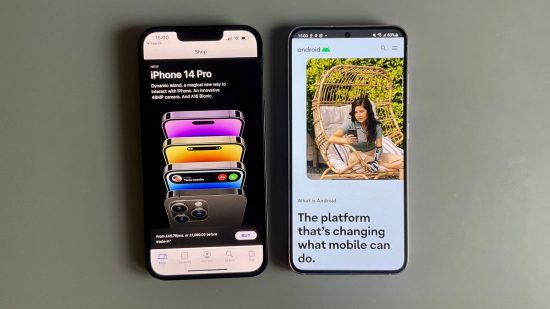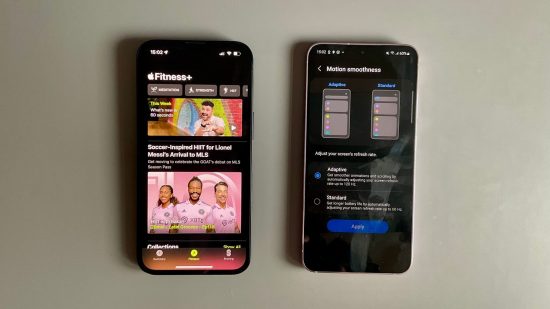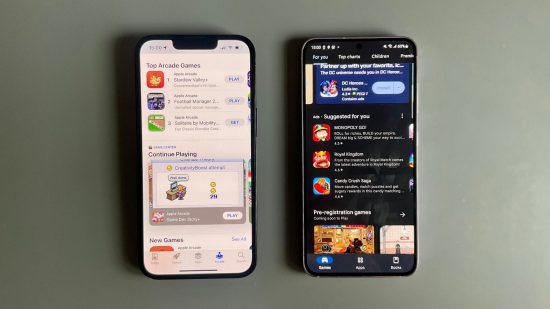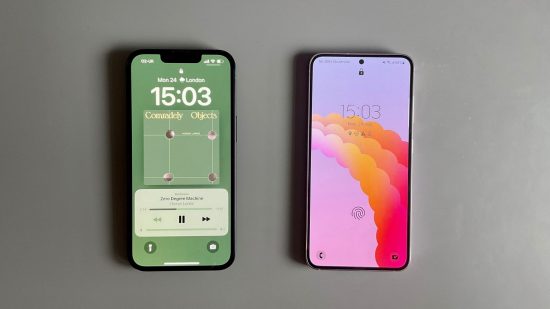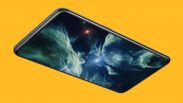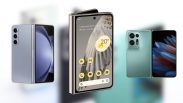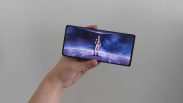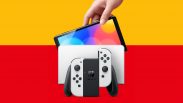Ah, the eternal question – iPhone vs. Android: which is better? This is by no means an easy fight to determine a clear winner. Both offer many benefits for certain people, while there are drawbacks to both, too. So, we’re here to break down everything to help you make the right decision for your next smartphone, whether it’s top-end software features or gaming services to make any mobile game a breeze.
Here at Pocket Tactics, we have years of experience testing both Android and iOS devices, from the most expensive flagships from Samsung, Xiaomi, and Apple, to the budget contenders from Redmi and Tecno. We even have experience with niche gaming-focused smartphones from the likes of Asus. We’ve really tried them all.
So, we’re well prepared to help you discover the best handset for you. Once you’ve chosen your operating system, you can take a peek at the best gaming phones, knowing more about what the different types offer. If you’re set on Android, the best Samsung phone may be for you, while any Apple die-hards will want to check out the best gaming iPhone to make the right choice.
iPhone vs. Android: which is better?
There are many different categories in which we can compare iPhone vs. Android, so if there’s a specific aspect you’re interested in, you can find it below.
Hardware
Hardware is a fundamental part of making a purchasing decision when it comes to a new smartphone. For all the different apps and OS differences, if the hardware isn’t good enough, you won’t be able to do everything you need to. While Apple and Android phones are often closely matched in hardware, there are some key differences in specific areas.
Flagships
When it comes to the highest-end smartphones on the market, Apple and Android compete closely. The most expensive iPhone has excellent performance, a competitive camera, and a gorgeous screen, something the best from Samsung and Xiaomi also have. Choosing between the two on the $1,000+ end is tough.
From Apple, there are only two handsets to choose from; the iPhone 14 Pro and the iPhone 14 Pro Max (though the iPhone 15 release date is right around the corner, so keep that in mind). There’s no difference between the Pro and the Pro Max other than the size of the handset, which could make all the difference for you.
From Android, Samsung is the clear leader, though there are more options than Apple. There’s the Samsung Galaxy S23 Ultra, the best flagship Android in our opinion. However, if you fancy something different, there’s the vivo X90 Pro+ and the Xiaomi 13 Pro, too. Check out our Xiaomi 13 Pro review to learn even more about the somewhat hard-to-find handset.
The pro range of iPhones offers Apple’s A16 Bionic chip, the most powerful chip in its smartphones. In terms of performance, it beats the top-end Android chip in most benchmarks, though that’s not the most important thing – the top-end iPhones have more than enough power for the most demanding users, and that’s all that matters.
This also applies to Android, however, with the Samsung S23 Ultra offering excellent power for all your needs, as well as competitive power efficiency, too. While one may be better than the other on paper, the difference between the top-end Android and iPhone chips is nominal. In everyday use, neither misses a beat.
In terms of screen technology, the Asus ROG Phone 7 Ultimate is the best on the market, though that’s a gaming-specific Android, not an all-around flagship. Check out our Asus ROG Phone 7 Ultimate review if you’re interested, though, for all other flagships, the screen tech is again very similar. Apple, Samsung, and Xiaomi all offer 120Hz OLED screens with similar brightness and pixel density. There are slight differences, but again they’re nominal.
Finally, on the high-end, it’s all about cameras. And this is where things get a little trickier. The Samsung S23 Ultra arguably has the best cameras you can get in a smartphone, though the upper-mid-range Google Pixel 7 Pro could also be considered best – and it’s hundreds of dollars cheaper. Meanwhile, the iPhone 14 Pro is the best phone for video, and the Xiaomi 13 Pro’s camera is no slouch either. If all you want is a great camera, it might be worth looking at our Google Pixel 7 Pro review and saving yourself some money, though the flagships are also excellent snappers.
The last key difference at the high end is the fact that there are foldable phones that run Android. Apple doesn’t make a foldable phone, and it doesn’t look likely that the Cupertino company will make one anytime soon. If you want a foldable phone, you have to go for Android, and Samsung is currently your best bet (though the competition is getting fiercer for sure).

Mid-range
The mid-range market is a little muddy, and it spans quite a wide price range. At the upper edge of the price range (around $800), there’s the Google Pixel 7 Pro, iPhone 14, and Samsung S23 (the latter two come in plus sizes as well). These aren’t quite flagships, though they’re pushing the definition of mid-range.
At this higher price point, the Google Pixel 7 Pro offers the best cameras, the Samsung S23 is a great all-rounder, and the iPhone 14 offers great integration into Apple’s ecosystem and a stellar chipset, too. All in all, there aren’t many key differences between the bunch, so choosing between them is down to the further comparisons below.
The proper mid-range phones on the market are where things get a bit more interesting. Here, phones cost between $350 and $600, and there are some real bargains available from a wide variety of manufacturers. The OnePlus Nord 2T is our pick of the bunch, with excellent features for its low price, while Samsung’s A54 and the Redmi Note 12 Pro offer great value from reliable brands. You can check out our Redmi Note 12 Pro 5G review to learn more.
From Apple, there’s only one mid-range handset: the iPhone SE. It still has the same old design as the iPhone 8 (a phone from 2017), though its innards are updated to keep its performance competitive. It has a good camera and excellent performance, though its old design and lack of a 120Hz refresh rate mean it’s not the easiest recommendation – unless you absolutely have to go for Apple, then you have no other choice. It’s still a great handset, though other phones offer more for your money in our opinion.
Budget
Apple doesn’t offer a truly budget handset, meaning that if you don’t have much money to spend, you cannot go for an Apple phone. That makes your decision quite a bit easier, of course, though there are quite a few phones to choose from in the budget market. You could buy an old iPhone from a different retailer, but the cheapest on offer from Apple itself is still the iPhone SE.
In terms of Android, there are lots of great budget options to choose from. Xiaomi has two budget subbrands, with the Redmi Note 11 offering excellent all-around performance for its low price. Meanwhile, as you can see in our Poco X5 review, Xiaomi’s gaming subbrand sure offers bang for your buck.
Meanwhile, Tecno – a very popular brand in emerging markets – offers some very impressive budget handsets. Our Tecno CAMON 20 Premier 5G review may not be a full-on love story, but the phone is a solid all-rounder. Meanwhile, our Tecno POVA 5 Free Fire Special Edition review has all the details for anyone hunting for a budget gaming phone.
Of course, there are excellent budget options from the bigger brands too, and these may offer better security updates and longer-term support, as we go into more detail about below. The Galaxy A series offers a wide range of phones at different price points to fit your budget, with that Samsung trustworthiness tied in, while the Pixel 6a is still available from Google at a discounted price that makes it a really tempting choice.
So, there’s clearly a very wide range of phones to choose from, whether you want to spend $100 or $1,000. While the hardware is often the focus for any prospective buyers, there are some key differences between iPhone and Android beyond what’s on the surface. So, let’s get stuck in.
Operating system
Choosing between Android and iOS is the biggest difference between the two competitors, though it’s not as grand a divide as you may think. There are some key differences, but fundamentally, both iPhone and Android can do most of what you need, they might just do it in different ways.
iOS
What is iOS? Well, it’s Apple’s operating system for iPhone, which means it’s the way you interact with the device and the different features it offers therein. Just like Android, it offers a wide variety of built-in apps, a massive App Store to find more, and a slick interface to get things done simply.
There are some key differences, however. First off, iOS is the same across all iPhones. No matter which handset you pick up, you have the same version of iOS (assuming it’s new enough to receive the latest updates). This is helpful if you’re used to iOS, or you want a consistent OS as you upgrade phones over the years.
iOS also doesn’t come with any random stuff pre-installed, a.k.a. bloatware. Not all Android phones do this – most of the big brands ask first before adding any junk – but iPhone never does anything like this which is nice. This is again a bonus for simplicity, meaning you only have exactly what you need.
Android
Android is the operating system used by Samsung, Google, and countless other phone manufacturers. While the operating system can differ between different companies – the different versions are called “skins”, sort of like an overlay on top of the base Android OS – there are still lots of similarities across Android phones.
The primary benefit of Android is customizability. Android isn’t a walled garden, meaning you can use different app stores, download stuff like ROMs and emulators, and access a wide variety of third-party systems to get things done. This is a benefit for the more tech literate out there; the people who know how to make the most of it. If you don’t know how to do it, it’s likely not a benefit.
Meanwhile, Android also lets you cater the operating system to your needs more minutely. For some people, this choice can be overwhelming, while others like to be able to customize their experience. Apple offers some customization, but only a small amount – if you’re a bit of a tinkerer, Android is likely for you.
But, while the operating systems offer different types of customization and accessibility, another key area to focus on is the features these systems have. This is where things get a bit more variable across different brands, so the decision might become a tad easier.
Key features
There are various features offered across iPhone and Android, many of which are available on both. Here, we break down key features unique to specific smartphones, so you can see what can only be done and where to do it.
Apple
iOS offers many features that you can get nowhere else. iMessage, the blue-bubbled messaging service only works between iOS devices, while FaceTime only recently allowed non-Apple devices to join a call, though it’s not integrated as smoothly as on Apple devices, of course. Then there are features like SharePlay, which lets you watch a film or listen to music with a friend while on a call, that, while niche, are also only available on Apple devices.
Meanwhile, the ecosystem integration with Apple is unmatched at the time of writing. You can copy something on your phone and paste it onto a Mac or iPad seamlessly, use your iPhone as a webcam or microphone, and set up new devices from your old devices easily. There are a bunch of other features like this, all of which make using an Apple Watch, Mac, or HomePod far easier. If you want any of those devices or already own them, we highly recommend going for iPhone.
Android
Android also offers features that Apple doesn’t. You can set up multiple users on a device if you’re sharing it with family or have different needs for work and leisure, which is super helpful (especially on a tablet!). Then there’s the added customizability as we mentioned earlier, letting you change all manner of settings for a bespoke experience.
The other big benefit of Android is that it’s open – you can download specific ROMs or APKs, which are basically install files, rather than going through an app store. This comes with its own risks, sure, but if you want the latest software for a phone left behind by the manufacturer, an old PS1 game, or all manner of other unique apps, Android is the best way to go (assuming you’re techy enough to do it safely; never download from unknown sources unless you know they’re safe).
Gaming
Gaming is a massive part of the mobile space, and both Apple and Android offer different benefits that come from two quite different angles. Of course, the broad hardware in the Android market means there are lots of gaming-focused phones, but Apple’s cross-device integration and growing services push help on the other side of the battle.
Apple
The main bonus to getting an iPhone for gaming is Apple Arcade, the company’s subscription service with a pile of excellent mobile games. There’s Google’s Play Pass on Android, but in terms of the quality of the games on the service, it can’t really match Apple.
Apple Arcade also has exclusive games, so if there’s something that’s caught your eye, make sure it’s not an iOS exclusive. We’ve got a list of the best Apple Arcade games so you can see what’s on the service, but for our money, it’s the best mobile gaming service available at the moment.
Apple also has great integration across all its devices. You can start playing something on your iPhone, pick back up on Mac, hop on the sofa and play it on your Apple TV, or lounge around with it on your iPad, with all your saves transferred over. What’s more, you can do this all with a Nintendo, Xbox, or PlayStation controller without any hassle connecting them up. Lovely.
Android
As above, Android does have a subscription service in the form of Google Play Pass, and while it has far more apps included, the quality is also far more variable. It’s good, but check out a list of games available on the service to make sure you’re happy with the selection.
Where Android is the clear winner, however, is with gaming-specific hardware. Whether it’s the best gaming phones from Asus or Redmagic, Android is the only place you can get phones specifically designed to be excellent at playing mobile games. If you want a phone like that, you know where to go.

Security
Security varies from brand to brand, and while Android has built-in security features, different manufacturers have different safeguards on top of it, making the Android side quite hard to parse. Companies like Samsung and Google have top-notch features to aid security, and many promise at least three years of software and security updates to keep you secure as your device gets old.
There are other companies, however, that don’t offer such lengthy support, so it’s important to check how long the company promises to keep you secure. Being aware of security risks is incredibly important, so be sure to research an individual handset and its manufacturer before diving in.
On the Apple side, however, things are a bit less fiddly. The company puts privacy and security at top billing in its marketing, but it’s not just a selling point – the walled garden of iOS means it’s easier to keep secure. iOS also lets you ask apps not to track you, meaning you can keep everything private even when downloading a new app.
Apple has recently started pushing rapid security response updates, too, which are quick fixes to minor issues. While we would never say you’re 100% secure using any device, Apple is our go-to – though Samsung also has a focus on security that shouldn’t be ignored, too.

Repairability
iPhone repairability is minimal. If you want to replace your screen or battery, you probably could, though it’s a little fiddly and frustrating, so it might be easier to go to an Apple Store or a professional to get it sorted for you. This is unlikely to change, too.
Meanwhile, many Android manufacturers pride themselves on their repairability. Nokia is a leader in this regard, with excellent tools to help you keep your phone running for longer with your own two hands, helping you stay green and keep your costs down while staying in the smartphone market. As always, repairability differs greatly across the Android market, so be sure to look into an individual handset before purchasing if repairability matters a lot to you.
iPhone vs. Android: which one should you choose?
Choosing between iPhone and Android is tough, though it becomes a lot easier once you know exactly what you need. If you want to keep things simple while using your phone and don’t need a super-budget handset, Apple is likely the best way to go. Meanwhile, if you have specific hardware needs not catered to by Apple, or fancy tinkering a bit with your phone by adding unique software and customizing the experience, that’s what Android can do for you.
Any casual user can expect an excellent experience from both sides of the tech coin – if you’re not going to delve deep into either, you’ll likely not see the many benefits and drawbacks that lie beneath. So, if you just need a phone for basic phone things, find a handset that looks nice at a good price and you should be happy with either Android or iOS.
For an easy metaphor, Apple’s iOS is like the most luxurious kindergarten you’ve ever been to – everything is super simple, easy, and really quite lovely, though there’s padding on all the table corners so you don’t hurt yourself; your freedom is limited. Meanwhile, Android is like going to university for the first time; it’s somewhere you can make dozens of different mistakes as you try and work your way through it all. But there’s also power in that independence. For me, I’m sticking to pre-school safety in iOS, but that’s not exactly adventurous, is it?
Read our how we test page to find out more about how we research the phones discussed in this article. Of course, choosing Android or iOS is only half the process for choosing a phone – read our guide on the best cell phone providers guide to help you pick the right service for you. If you know you want something durable, read our list of the best rugged smartphones too.

